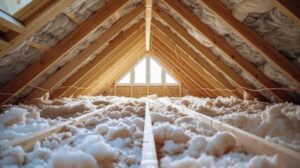
In today’s market, Kitchen Remodeling Lexington KY is a great way to boost home value. It also provides a comfortable and functional space for cooking and enjoying time with family and friends.
Consider your budget before starting a remodel. Also, it’s important to understand the layout and design before buying materials or products.
1. Increased Value
Homeowners who invest in a well-done kitchen remodel are likely to recoup most of their costs when they sell. In fact, a remodeled kitchen may even increase your property value enough to offset the cost of the upgrade!
Remodeling your kitchen allows you to design a space that fits your lifestyle. What worked for the previous owners or a builder-standard layout might not work for you. By choosing a custom layout that makes sense for your family, you’ll be able to enjoy your space. Plus, having an efficient kitchen will help you spend less time on chores and more time with your loved ones.
Kitchen remodeling also offers a great opportunity to update your kitchen with modern materials and trends. New countertop options, updated appliances, and more can give your kitchen a fresh look that’ll appeal to potential homebuyers. This is particularly important if you plan to sell your home in the future.
By making a few strategic upgrades, you can turn your old and outdated kitchen into a modern paradise that’s sure to impress your guests. However, be sure to work with a trusted remodeling company, like Seacoast Cabinet, to ensure your vision comes to life.
The difference between a renovation and a remodel is that remodeling typically involves a complete overhaul of the space. This can include changing the layout, moving walls, and altering the location of electrical and plumbing fixtures. On the other hand, a renovation is less extensive and typically focuses on updating existing elements with modern features, like new appliances or a stylish backsplash.
The final decision about whether you should renovate or remodel your kitchen should ultimately come down to your budget and goals. It’s important to be realistic about what can fit into your budget, so you don’t end up with a kitchen that you’re not completely happy with or can’t afford to maintain.
2. Aesthetics
Kitchen remodeling offers homeowners a chance to enhance aesthetics and create a culinary space that not only serves as an efficient workspace but also reflects their personal style. By strategically planning the layout, upgrading appliances, implementing smart storage solutions, and choosing durable materials, homeowners can create a kitchen that’s not only functional but also beautiful and inviting.
Aesthetics can be enhanced through a variety of ways, including repainting cabinets, adding a backsplash, or replacing outdated fixtures. These upgrades can drastically change the look of a kitchen without altering the existing layout or requiring major construction.
Using durable, stain-resistant materials can also add to the aesthetics of a kitchen. For example, quartz countertops and hardwood flooring are visually appealing and can withstand years of wear and tear. Similarly, subway tile backsplashes and beadboard paneling are timeless additions that can complement any kitchen design.
Lighting is another key aspect that can improve the overall appearance of a kitchen. Using a combination of ambient, task, and accent lighting can help set the mood for any kitchen and highlight features like islands and dining areas. Additionally, statement lighting fixtures like pendants and chandeliers can provide a focal point that catches the eye.
Ultimately, it’s the little details that can make a big difference. Consider the finishing touches like cabinet hardware, hardware finishes, and faucets to ensure that they align with your desired design theme. Additionally, arranging a temporary kitchen and cooking in it as you normally would can give you a sense of how the design will work before you commit to it.
Kitchen remodeling is an opportunity to create a space that combines functionality with beauty. By optimizing the layout, incorporating smart storage solutions, utilizing durable materials, and embracing thoughtful design details, homeowners can transform their kitchen into an aesthetically pleasing culinary space that reflects their lifestyle and tastes.
3. Functionality
Kitchen remodeling gives you the opportunity to create a kitchen that fits your family’s needs and lifestyle. You can choose to go for a complete overhaul that transforms your entire space, or you can opt for a partial remodel to refresh your existing elements.
Whatever your goals for the space, working with a design-build partner will help you identify the negatives and positives of the layout and then incorporate solutions to improve functionality. Key areas to focus on include storage, workflow, lighting, and room relationships.
Storage: Maximize the amount of storage by installing cabinets that fit the space and adding pull-out shelves to make it easy to access frequently used items. Also consider adding a kitchen island if you have the space for it, which not only provides an attractive focal point but can also provide additional workspace.
Workflow: Every kitchen has what’s known as a “working triangle” consisting of the sink, refrigerator, and stove. Ideally, these three areas are within an efficient distance of one another so that you can easily move between them when cooking.
Room Relationships: The space between your kitchen and other rooms can affect efficiency as you move into, out of, and around the home. By incorporating visual boundaries, such as different flooring and wall colors or textures, you can separate the spaces without creating barriers that will hinder the flow of movement.
Multi-Person Functionality: Many people cook together or have a significant other who assists with cooking tasks. With some creative planning, the classic “working triangle” can be expanded to accommodate these needs by adding a second sink and a variety of counters and workspaces for two cooks to work side-by-side.
4. Energy Efficiency
The kitchen is the heart of almost every home; it’s where families gather to eat and catch up after a long day. It’s also one of the busiest rooms in your house, so it uses a significant amount of energy. A new kitchen that takes energy efficiency into account can help reduce your utility costs, increase your home’s value, and decrease its environmental impact.
Inefficient lighting, leaky faucets, and poor insulation are common causes of excessive energy usage in kitchens. Upgrading to energy-efficient bulbs and smart lighting controls can significantly reduce your electricity usage, while still providing bright and comfortable illumination in your Temecula kitchen. Maximizing natural light and incorporating reflective materials such as backsplashes and countertops can further decrease your energy consumption.
Choosing eco-friendly appliances and materials during your kitchen remodel is another great way to increase energy efficiency. ENERGY STAR-rated refrigerators, dishwashers, and ovens use less energy and water than conventional models, helping to lower your energy bills and minimize your home’s carbon footprint. Investing in eco-friendly countertop materials like recycled glass and sustainable wood can also reduce your ecological footprint. Adding low-flow faucets and dishwashers, and installing a hot water recirculation system can further reduce water usage while saving you money on your utility bill.
Lastly, making sure your home has sufficient ventilation can also improve energy efficiency. Investing in an energy-efficient range hood can effectively remove cooking odors and pollutants while minimizing your home’s energy usage.
5. Environmentally Friendly
Kitchen remodeling is a great opportunity for homeowners to upgrade outdated appliances to eco-friendly models. This will not only save energy but also decrease household carbon footprint. A new fridge with a water-saving feature or a low-flow faucet will reduce your family’s water usage, while an energy efficient dishwasher and oven can help cut down on electricity use.
Homeowners can choose from a variety of environmentally friendly materials during the remodeling process, such as bamboo countertops or recycled glass tiles. These sustainable solutions are becoming increasingly popular among consumers as the demand for eco-conscious products grows.
Another way to make your home more environmentally friendly is by installing a tankless water heater that will reduce the amount of water you waste. These kinds of upgrades will increase your resale value and will also benefit the environment.
When your kitchen isn’t spacious enough, you will have to store most of your stuff in the living room and it can be difficult to maneuver around the space. Having a larger kitchen will allow you to store more things, keep everything organized and easier to find, and give everyone in your family plenty of room to move.
Having older appliances in your kitchen can be a fire hazard and can cause electric shocks. Upgrading to newer models with built-in safety features will decrease the risk of accidents.
While kitchen remodels can be a major project, it doesn’t have to be an all-out renovation. A partial remodel can be a great solution for homeowners who want to refresh their kitchen without spending too much money or time. A professional will be able to determine what kind of remodel is best for your kitchen and offer recommendations that will suit your unique needs.








